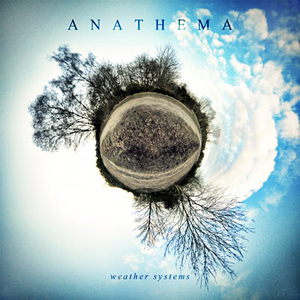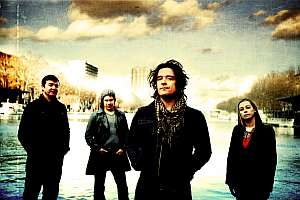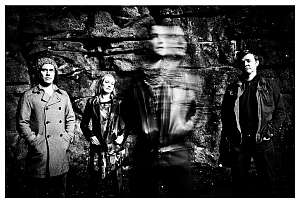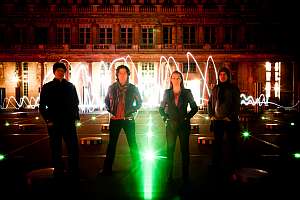 Danny Cavanagh (Anathema) about
Danny Cavanagh (Anathema) about
Weather Systems
Last April, Liverpool's cult outfit ANATHEMA has released ‘Weather Systems’. Produced by five Norwegian Grammy nominee Christer-André Cederberg, critically acclaimed new studio album delivers eight compositions. Do you want to learn about the genesis of ‘Weather Systems’? Explore its spiritual background, find out what RADIOHEAD songs have in common with ANATHEMA's newest release and get familiar with an unusual story hidden behind ‘Lightning Song’? All included in brand new interview with co-founder and band guitarist Danny Cavanagh.
Danny about the whole album
Originally ‘Weather Systems’ was going to be EP and then become expanded to a full album with the addition of four songs. The five ‘Weather Systems’ songs were: ‘The Gathering of the Clouds’, ‘Lightning Song’, ‘The Storm Before the Calm’, ‘Sunlight’ and ‘Internal Landscapes’. When we finished “Internal Landscapes”, it was so good that we thought it just must be an album, with four more songs, to make even it more great. That’s why we decided to release it as the album. It was simply a case of extending and finding the right four songs. We chose ‘Untouchable, Part 1’, ‘Untouchable, Part 2’, ‘The Beginning and the End’ and ‘Lost Child’, which were the best songs that we had.
Untouchable, Part 1
‘Untouchable, Part 1’ was written when I lived in Norway. It's about letting go of love and moving on, even though you want to make final statement. It's a final statement of love, blessing somebody and about moving past that, but still stating how beautiful your feelings are. You can't hold on too much to somebody, you have to let them be who they are. If you really  love somebody, you let them be themselves. That's the whole idea. You have to let go, if somebody is not going to feel what you want from them, you must let go. That's the story behind that one.
love somebody, you let them be themselves. That's the whole idea. You have to let go, if somebody is not going to feel what you want from them, you must let go. That's the story behind that one.
Untouchable, Part 2
It's straight from Norway too. Musically those songs are very strong and probably the most recent on the album. They were recorded in summer 2011 and written only at the beginning of 2011, so they are quite new. The reason why I like them, is partly because they were recorded quickly after there were written, which is quite a new thing for Anathema and I like that.
Gathering of the Clouds
That's one of the oldest songs, and that was written back in 2005/2006. The chords have been around for a while and it's really just a grew over the years. It's connected to the ‘Lightning song’, they both been completed in 2005/2006.
Lightning Song
Bringing Lee Douglas in for the ‘Lightning Song’ was a good move and it also was intended for female voice, so that worked very well. Both of them (‘Gathering of the Clouds’ and ‘Lightning Song’) are about emotions, enlightenment, and being free of fear. Obviously they join the power of weather and climate, bringing that towards your internal nature, storms and the calm of the mind.
Sunlight
Is the part of the same trilogy of songs, they were really written to be together. I wrote the melody of the chords, and I began in 2001. I was playing RADIOHEAD songs on the guitar, and when I was playing ‘Fake Plastic Trees’, then I just came up with ‘Sunlight’, sort of like a continuation. When I'm playing a song that I love, it just sometimes happen that I'm finishing, I continue playing and improvising after that. That happened few times and that happened on ‘Sunlight’ with ‘Fake Plastic Trees’. Lyrically it talks about becoming free again after some very difficult time and crisis. The point is to see life’s moments and to feel peace, to see the nature of inner the peace, what it really is and to equate that sunlight after lightning the storm.
Storm before the Calm
The title really ties in with these songs. That was written by John Douglas. He's talking about an  internal mind and difficult things. He independently chose that title a long time before we ever decided on the title ‘Weather Systems’, so that really fitted also. That's really a big, big song from John, produced heavenly by Vincent and by Christer (Christer-André Cederberg). A very good song indeed.
internal mind and difficult things. He independently chose that title a long time before we ever decided on the title ‘Weather Systems’, so that really fitted also. That's really a big, big song from John, produced heavenly by Vincent and by Christer (Christer-André Cederberg). A very good song indeed.
The Beginning and the End
It’s an another new song. The guitar riff was written at the same time as recording of ‘We're Here Because We're Here’, so I would say in 2009, then it moved to a piano part. Everybody liked it, so just immediately we saw this was one of our classic tracks, just because of the riff itself. Writing the vocal came quite easily from there, it wasn't a difficult song to write, it was quite simple and straightforward. It was good to record. I enjoyed the guitar sound and the process of writing. Completing that song and the recording was very much fun, and I loved the vocals, they’re great. That was a good one. The most interesting story is probably from ‘The Lost Child’ which came from a dream. During the recording of ‘We're Here Because We're Here’, I dreamed one night and I woke up with this melody in my mind.
In the dream there was a very tall building and at the top of it lied an orphanage where lost children lived. Inside there was a room with a boy singing this tune as the form of protest. Nurses in the orphanage couldn’t get him to stop. They were saying to him: "please stop singing, please play with your toys, please play with the other children". He wouldn’t listen to them, all he would do was to sing this tune. I went in into the room and I said: “Don't stop him, it's a beautiful tune.” I took him into the room with a piano, we found the notes and when we started playing the song together, he was happy. Then I woke up in the middle of the night and the tune filled in my mind. Before I could turn around and fall back asleep, I jumped out of the bed and found notes on piano and they stayed with me. That's how this song started. Lyrically the song deals with being lost inside, being in the dark, a difficult position and needing help.
Internal Landscapes
The final song on the album deals with death , light and transcending to higher dimensions of existence. It's based primarily on the true story of Joe Geraci, who in late seventies had very serious illness and almost died. As you can hear in the story he presents in ‘Internal Landscapes’, he went into a beautiful bright, light and timeless place. It was so powerful and overwhelming, that after he came round from the illness, it took him si x months to tell anybody about it, even his wife. It was amazing when I heard him speaking about it. So many of the things he said (about no time and things like this) - it really tied in with my researches into the possibility of the spiritual dimensions. You don't actually hear about that in the song, but the interview was longer. I thought to myself: this man has really been there. I put his voice in the song and it worked and fit very well. I wrote lyrics a little bit based on his experience and a little bit on my own stuff about light, love, warmness, peace and letting go. Always being there in heart, in mind, being at ease with your own spirit. After that, it took me four months to find a way to get permission to use this speech. In the end it happened that I got in touch with Kenneth Ring, a gentlemen who interviewed Joe. He's a writer, researcher and professor. Ken put me in touch with Joe, who's still alive in America. We have now a wonderful friendship with Joe and we influence each other lives. He's now recording poetry he wrote about his experience and the other things. I'm making music based on poetry. So it makes a difference for him, it also brought the album some really good heart and focus, it's very nice. Very lovely thing, it also completed a circle in a way.
x months to tell anybody about it, even his wife. It was amazing when I heard him speaking about it. So many of the things he said (about no time and things like this) - it really tied in with my researches into the possibility of the spiritual dimensions. You don't actually hear about that in the song, but the interview was longer. I thought to myself: this man has really been there. I put his voice in the song and it worked and fit very well. I wrote lyrics a little bit based on his experience and a little bit on my own stuff about light, love, warmness, peace and letting go. Always being there in heart, in mind, being at ease with your own spirit. After that, it took me four months to find a way to get permission to use this speech. In the end it happened that I got in touch with Kenneth Ring, a gentlemen who interviewed Joe. He's a writer, researcher and professor. Ken put me in touch with Joe, who's still alive in America. We have now a wonderful friendship with Joe and we influence each other lives. He's now recording poetry he wrote about his experience and the other things. I'm making music based on poetry. So it makes a difference for him, it also brought the album some really good heart and focus, it's very nice. Very lovely thing, it also completed a circle in a way.
On ‘Presence’ from ‘We're Here because We're Here’, ANATHEMA has used a quote from an Eckhart Tolle’s book ‘Stillness Speaks’: “Death is not the opposite of life. Life has no opposite. The opposite of death is birth. Life is eternal…” How did the band found out about him?
Stan Ambrose is the guy who was interviewed on ‘Presence’. He is a well known radio presenter in Liverpool and he got me familiar with the person of Eckhart Tolle. Then I interviewed him about the subject shortly after that, I think one day or two days later, and that's the interview that we used. I like Eckhart, I think he's a funny man, he speaks some great issues and he's a very simple, honest and straightforward person. It's beautiful anyway. He makes me laugh. I can't help feeling that there's a lot of peace and truth in what he says. I don't put myself under pressure to live that way, but every time I listen to him I find him funny, enlightening, rewarding. I think what he points is beautiful. If anybody has been "there", it's him.
It explains a lot. Exploring your subconscious mind and finding new layers of spirituality... it didn't start on just the previous album.
It has always been there, even songs like ‘Are you there?’, it was there even then. It was there and runs through that song. It's just my way of doing it, my way of working, my way of creating art. If this stuff it's real, if higher dimensions do exists, if consciousness does survive death, it is the unique and most important thing in the universe to us. The implications are vast. It means that there's an answer and there's a reason, and it means there's an unbelievable love and beauty in the world, and a meaning behind that love. This is a fundamental question of life and something I’m very interested in, something I'm open minded to, because I do think some of the experiences I have had cannot be logically explained.
Pictures by Rod Maurice
Links: Anathema Website / Anathema Facebook






Comments powered by CComment